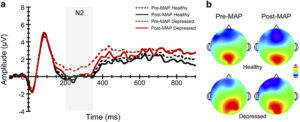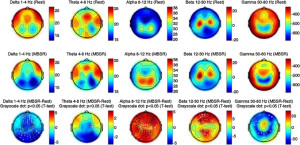
By John M. de Castro, Ph.D.
“Loving-kindness meditation does far more than produce momentary good feelings. . . . this type of meditation increased people’s experiences of positive emotions. . . . it actually puts people on “trajectories of growth,” leaving them better able to ward off depression and “become ever more satisfied with life.”” – Christine Carter
Humans are social animals. This is a great asset for the species as the effort of the individual is amplified by cooperation. In primitive times, this cooperation was essential for survival. But in modern times it is also essential, not for survival but rather for making a living and for the happiness of the individual. This ability to cooperate is so essential to human flourishing that it is built deep into our DNA and is reflected in the structure of the human nervous system. Empathy and compassion are essential for appropriate social engagement and cooperation. In order for these abilities to emerge and strengthen, individuals must be able to see that other people are very much like themselves.
Unfortunately, there is very little understanding of the factors that lead to and improve empathy and compassion. One method that appears to be able to increase these capacities is Loving Kindness Meditation (LKM). It has been shown to amplify positive emotions, altruism, and compassion. This suggests that LKM may reduce the perceived difference between the self and other people. This is difficult to study, however, as these capacities are not easily measured and require length, indirect, paper and pencil, tests for assessment.
An alternative assessment technique is to measure the electrical response of the brain (electroencephalogram, EEG) as an indicator of empathy and compassion. This can be done by investigating differences in the brains processing of stimuli related to the self, relative to those related to other people. Upon presentation of these stimuli differences in the brain’s response can be seen called the evoked potential (ERP). The P300 response in the evoked potential (ERP) occurs between 3 to 6-tenths of a second following the stimulus presentation. It is a positive change that is maximally measured over the central frontal lobe. The P300 response has been associated with self-processing. It is larger in response to stimuli such as one’s own name, face, or information about the person’s history. So, the P300 response is often used as a measure of the processing of information about the self, with the larger the positive change the greater the self-processing.
In today’s Research News article “Decentering the self? Preliminary evidence for changes in self- vs. other related processing as a long-term outcome of loving-kindness meditation.” See:
or see summary below or view the full text of the study at:
Trautwein and colleagues employ the P300 response in the evoked potential (ERP) in response to pictures of the self or a close friend to investigate the effectiveness of Loving Kindness Meditation (LKM) to improve empathy and compassion in humans. They recruited adult long-term practitioners of LKM and a group of age, gender, handedness, and education matched non-meditators. The participants were asked to press a button every time a picture of either themselves of their friend was presented amid a series of other stimuli. This occurred on 20% of the time. They measured performed this task while wearing scalp electrodes to measure the EEG and the P300 response to these stimuli was recorded.
They found that, as expected, the LKM practitioners reported experiencing more compassionate love for strangers and all of humanity than control participants. They also found that, as expected, the P300 response in the parietal lobe of the brain was greater to the picture of the self than the friend. As a measure of the degree to which the participant viewed the self and other as similar, they measured the difference in the ERP response to the self vs. friend picture. They found that the smaller the difference between the self vs. friend P300 response the greater the levels of self-reported compassion. Importantly, they also found that the greater the amount of LKM practice the smaller the difference in the P300 response to self and friend.
These results are interesting and suggest that Loving Kindness Meditation (LKM) improves empathy and compassion by altering the brain’s response to self vs. others. In this way, individuals perceive other people as more like themselves, making them more compassionate and empathetic. It should be noted, however, that there was not a comparison group of meditators who did not practice LKM. So, it cannot be concluded that the effects were due to LKM practice specifically. It could be that any form of meditation practice would have similar effects. But, it is clear that meditation alters the brain’s response to self vs. others.
So, improve seeing others as like the self with Loving Kindness Meditation.
“The practice of LKM led to shifts in people’s daily experiences of a wide range of positive emotions, including love, joy, gratitude, contentment, hope, pride, interest, amusement, and awe. These shifts in positive emotions took time to appear and were not large in magnitude, but over the course of 9 weeks, they were linked to increases in a variety of personal resources, including mindful attention, self-acceptance, positive relationships with others, and good physical health…They enabled people to become more satisfied with their lives and to experience fewer symptoms of depression.” – Barbara Fredrickson
CMCS – Center for Mindfulness and Contemplative Studies
This and other Contemplative Studies posts are also available on Google+ https://plus.google.com/106784388191201299496/posts
Study Summary
Fynn-Mathis Trautwein, José Raúl Naranjo, and Stefan Schmidt Decentering the self? Preliminary evidence for changes in self- vs. other related processing as a long-term outcome of loving-kindness meditation. Front. Psychol., 21 November 2016 | http://dx.doi.org/10.3389/fpsyg.2016.01785
Research in social neuroscience provides increasing evidence that self and other are interconnected, both on a conceptual and on an affective representational level. Moreover, the ability to recognize the other as “like the self” is thought to be essential for social phenomena like empathy and compassion. Meditation practices such as loving-kindness meditation (LKM) have been found to enhance these capacities. Therefore, we investigated whether LKM is associated to an increased integration of self–other-representations. As an indicator, we assessed the P300 event-related potential elicited by oddball stimuli of the self-face and a close other’s face in 12 long-term practitioners of LKM and 12 matched controls. In line with previous studies, the self elicited larger P300 amplitudes than close other. This effect was reduced in the meditation sample at parietal but not frontal midline sites. Within this group, smaller differences between self- and other-related P300 were associated with increasing meditation practice. Across groups, smaller P300 differences correlated with self-reported compassion. In meditators, we also investigated the effect of a short LKM compared to a control priming procedure in order to test whether the state induction would additionally modulate self- vs. other-related P300. However, no effect of the priming conditions was observed. Overall, our findings provide preliminary evidence that prolonged meditation practice may modulate self- vs. other-related processing, accompanied by an increase in compassion. Further evidence is needed, however, to show if this is a direct outcome of loving-kindness meditation.








